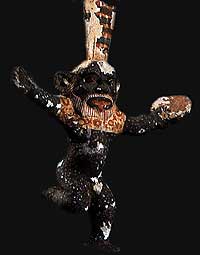 |
Represented as a dwarf
with a large head, big eyes, protruding tongue and bow legs
(sometimes also shown with a crown of feathers and a bushy tail).
Unusually he was normally shown face-on rather than in profile
- (as such he is often found portrayed on mirrors, ointment jars
and other such items). The very appearance of Bes was cause to
give joy and good temper - his ugly looks were used to drive
away evil spirits or bad influences, harmful reptiles, scorpions
or similar type animals.
Origins of Bes
The non-Egyptian look
of Bes has led to speculation as to his origins - he was often
described as 'Coming from the Divine Land' - which could mean
from the east, or elsewhere in Africa, Asia or perhaps Babylonian.
He could also be described as the 'Lord of Pwene' - which indicates
his beginnings in the mysterious land of Punt.
|
Perhaps Bes is most identified
with his role as a protector of childbirth - when problems arose
during a delivery a clay dwarf was placed on the head of the
mother and a spell was recited 4 times calling upon the dwarf
god to help (in the spell the god is described as 'Great Dwarf'
with a large head, short thighs and as a monkey in old age. Bes
was also present in scenes showing royal births - something which
was especially true during the Ptolemaic and Roman periods.
Images of Bes would normally
be found in the home, sometimes he would be closely connected
with Horus - stelae have been found which were called 'Horus
on the crocodiles'; on the stela a young Horus (shown face-on)
tightly holds reptiles or wild animals while he tramples on crocodiles,
however this version of Horus has the face of Bes. A few lines
of inscription are found on the back of the stela:
'You
protect me against all the wild beasts of the desert,
all the
crocodiles of the river,
all the
snakes and scorpions,
all the
insects that bite with their mandibles and sting with their tail,
all the
kinds of reptiles that attack in their caves"
It has
been suggested that these lines are a magical spell to give protection
against such animals mentioned in the text
| In the Greek Period of ancient Egyptian
history, there was a dramatic increase in the amount of images
of Bes - both in numbers of amulets, figurines and so on, but
also in the amount of large scale reliefs (he appears in the
temples at Dendera and Abydos for example), this period also
saw Bes elevated to the Egyptian Pantheon alongside the 'Great
Gods'. At the funerary temple of Seti I in Abydos oracles would
sit and ask Bes questions on behalf of the people - this may
have included questions about dreams, but more likely questions
people would have about their lives (whether they would get married,
would they be sick, would Bes have a look at their money matters
...) - these questions would be written down on papyrus and left
for the oracle. |
 |
|


